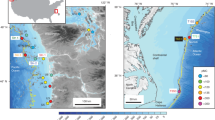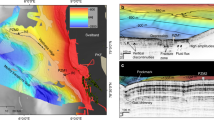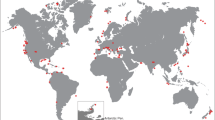Abstract
The fluxes of the greenhouse gas methane from many individual sources to the atmosphere are not well constrained1. Marine geological sources may be significant2, but they are poorly quantified and are not included in the Intergovernmental Panel on Climate Change budget1. Previous results based on traditional indirect sampling techniques and modelling suggested bubble plumes emitted from marine seeps at depths greater than 200 m do not reach the surface mixed layer because of bubble dissolution and methane oxidation3,4,5. Here we report methane concentration and isotope-depth profiles from direct submersible sampling of deepwater (550–600 m) hydrocarbon plumes in the Gulf of Mexico. We show that bubble size, upwelling flows and the presence of surfactants inhibit bubble dissolution, and that methane oxidation is negligible. Consequently, methane concentrations in surface waters are up to 1,000 times saturation with respect to atmospheric equilibrium. We estimate that diffusive atmospheric methane fluxes from individual plumes are one to three orders of magnitude greater than estimates from shallow-water seeps6,7,8, greatly expanding the depth range from which methane seep emissions should be considered significant. Given the widespread occurrence of deepwater seeps, we suggest that current estimates of the global oceanic methane flux to the atmosphere1 may be too low.
This is a preview of subscription content, access via your institution
Access options
Subscribe to this journal
Receive 12 print issues and online access
$259.00 per year
only $21.58 per issue
Buy this article
- Purchase on Springer Link
- Instant access to full article PDF
Prices may be subject to local taxes which are calculated during checkout



Similar content being viewed by others
References
Denman, K. L. et al. in IPCC Climate Change 2007: The Physical Science Basis (eds Solomon, S. D. et al.) 499–588 (Cambridge Univ. Press, 2007).
Etiope, G., Lassey, K. R., Klusman, R. W. & Boschi, E. Reappraisal of the fossil methane budget and related emission from geologic sources. Geophys. Res. Lett. 35, L09307 (2008).
Valentine, D. L., Blanton, D. C., Reeburgh, W. S. & Kastner, M. Water column methane oxidation adjacent to an area of active hydrate dissociation, Eel River Basin. Geochim. Cosmochim. Acta 65, 2633–2640 (2001).
Grant, N. J. & Whiticar, M. J. Stable carbon isotopic evidence for methane oxidation in plumes above Hydrate Ridge, Cascadia Oregon Margin. Glob. Biogeochem. Cycles 16, 1124 (2002).
McGinnis, D. F., Greinert, J., Artemov, Y., Beaubien, S. E. & Wüest, A. Fate of rising methane bubbles in stratified waters: How much methane reaches the atmosphere? J. Geophys. Res. 111, C09007 (2006).
Kessler, J. D. et al. Basin-wide estimates of the input of methane from seeps and clathrates to the Black Sea. Earth Planet. Sci. Lett. 243, 366–375 (2006).
Yoshida, O., Inoue, Y., Watanabe, S., Noriki, S. & Wakatsuchi, M. Methane in the western part of the Sea of Okhotsk in 1998–2000. J. Geophys. Res. 109, C09S12 (2004).
Schmale, O., Greinert, J. & Rehder, G. Methane emission from high-intensity marine gas seeps in the Black Sea into the atmosphere. Geophys. Res. Lett. 32, L07609 (2005).
De Beukelaer, S. M. Remote Sensing Analysis of Natural Oil and Gas Seeps on the Continental Slope of the Northern Gulf of Mexico. MSc thesis, College Station, Texas A&M Univ. (2003).
Leifer, I. & MacDonald, I. Dynamics of the gas flux from shallow gas hydrate deposits: Interaction between oily hydrate bubbles and the oceanic environment. Earth Planet. Sci. Lett. 210, 411–424 (2003).
MacDonald, I. R. et al. Transfer of hydrocarbons from natural seeps to the water column and atmosphere. Geofluids 2, 95–107 (2002).
MacDonald, I. R., Kastner, M. & Leifer, I. Estimates of natural hydrocarbon flux in the Gulf of Mexico basin from remote sensing data. EGU General Assembly Proc. abstr. EGU-05-A-09970 (2005).
MacDonald, I. R. et al. Asphalt volcanism and chemosynthetic life in the Campeche Knolls: Gulf of Mexico. Science 304, 999–1002 (2004).
Kessler, J. D., Reeburgh, W. S. & Tyler, S. C. Controls on methane concentration and stable isotope (δ2H–CH4 and δ13C–CH4) distributions in the water columns of the Black Sea and Cariaco Basin. Glob. Biogeochem. Cycles 20, GB4004 (2006).
Leifer, I., Luyendyk, B. P., Boles, J. & Clark, J. F. Natural marine seepage blowout: Contribution to atmospheric methane. Glob. Biogeochem. Cycles 20, GB3008 (2006).
Rehder, G., Leifer, I., Brewer, P. G., Friederich, G. & Peltzer, E. T. Controls on bubble dissolution inside and outside the hydrate stability field from open ocean field experiments and numerical modeling. Mar. Chem. 10.1016/j.marchem.2009.03.004 (2009).
Tilbrook, B. D. & Karl, D. M. Methane sources, distributions and sinks from California coastal waters to the oligotrophic North Pacific gyre. Mar. Chem. 49, 51–64 (1995).
Holmes, M. E., Sansone, F. J., Rust, T. M. & Popp, B. N. Methane production, consumption, and air–sea exchange in the open ocean: An evaluation based on carbon isotopic ratios. Glob. Biogeochem. Cycles 14, 1–10 (2000).
Karl, D. M. et al. Aerobic production of methane in the sea. Nature Geosci. 1, 473–478 (2008).
Head, I. M., Jones, D. M. & Röling, W. F. M. Marine microorganisms make a meal of oil. Nature Rev. Microbiol. 4, 173–182 (2006).
Weatherly, G. Intermediate depth circulation in the Gulf of Mexico: PALACE float results for the Gulf of Mexico between April 1998 to March 2002. OCS Study MMS 2004-013 (US Department of Interior, Minerals Management Service).
Owens, N. J. P., Law, C. S., Mantoura, R. F. C., Burkill, P. H. & Llewellyn, C. A. Methane flux to the atmosphere from the Arabian Sea. Nature 354, 293–296 (1991).
Frye, M. Preliminary Evaluation of in-Place Gas Hydrate Resources: Gulf of Mexico Outer Continental Shelf. MMS Report 2008-004 (US Department of Interior, Minerals Management Service, 2008).
Hovland, M., Judd, A. G. & Burke, R. A. Jr The global flux of methane from shallow submarine sediments. Chemosphere 26, 559–578 (1993).
Kinnaman, F. S., Valentine, D. L. & Tyler, S. C. Carbon and hydrogen isotope fractionation associated with the aerobic microbial oxidation of methane, ethane, propane and butane. Geochim. Cosmochim. Acta 71, 271–283 (2007).
Sansone, F. J., Popp, B. N., Gasc, A., Rust, T. M. & Graham, A. W. Highly elevated methane in the eastern tropical North Pacific and associated isotopically enriched fluxes to the atmosphere. Geophys. Res. Lett. 28, 4567–4570 (2001).
Yamamoto, S., Alcauskas, J. B. & Crozier, T. E. Solubility of methane in distilled water and seawater. J. Chem. Eng. Data 21, 78–80 (1976).
Wanninkhof, R. Relationship between wind speed and gas exchange over the ocean. J. Geophys. Res. 97, 7373–7382 (1992).
Mau, S. et al. Dissolved methane distributions and air–sea flux in the plume of a massive seep field, Coal Oil Point, California. Geophys. Res. Lett. 34, L22603 (2007).
Frew, N. M. et al. Air–sea gas transfer: Its dependence on wind stress, small-scale roughness, and surface films. J. Geophys. Res. 109, C08S17 (2004).
Acknowledgements
We thank the crew members and pilots of the R/V Seward Johnson and Johnson Sea-Link for their support in meeting the objectives of the 2002 and 2003 dive programs. We thank D. Valentine for use of his laboratory for the C1–C3 hydrocarbon analyses, and F. Kinnaman, B. Deck, R. Solem and T. Rust for technical assistance. We greatly appreciate the shipboard assistance from G. Robertson and the numerous UCSD and Texas A&M students during the 2002 and 2003 research expeditions. J. Kessler and J. Greinert are thanked for constructive comments, which helped improve the manuscript. Research financial support was provided by the US Department of Energy National Methane Hydrates R&D Program.
Author information
Authors and Affiliations
Contributions
E.A.S. carried out the chemical analyses and the methane oxidation/diffusive flux calculations, evaluated the results and wrote the manuscript. M.K., I.R.M. and E.A.S. oversaw the two field campaigns and sample acquisition. The numerical bubble propagation simulations were conducted by I.L. All authors provided valuable comments on the manuscript.
Corresponding author
Supplementary information
Supplementary Fig. S1
Supplementary Information (PDF 1391 kb)
Rights and permissions
About this article
Cite this article
Solomon, E., Kastner, M., MacDonald, I. et al. Considerable methane fluxes to the atmosphere from hydrocarbon seeps in the Gulf of Mexico. Nature Geosci 2, 561–565 (2009). https://doi.org/10.1038/ngeo574
Received:
Accepted:
Published:
Issue Date:
DOI: https://doi.org/10.1038/ngeo574
This article is cited by
-
Widespread natural methane and oil leakage from sub-marine Arctic reservoirs
Nature Communications (2023)
-
Automatic segmentation of gas plumes from multibeam water column images using a U-shape network
Journal of Oceanology and Limnology (2023)
-
Multi-beam and seismic investigations of the active Haima cold seeps, northwestern South China Sea
Acta Oceanologica Sinica (2021)
-
Impact of tides and sea-level on deep-sea Arctic methane emissions
Nature Communications (2020)
-
Acoustic characteristics of cold-seep methane bubble behavior in the water column and its potential environmental impact
Acta Oceanologica Sinica (2020)



